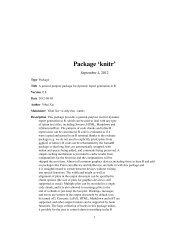Package 'openair'
Package 'openair'
Package 'openair'
You also want an ePaper? Increase the reach of your titles
YUMPU automatically turns print PDFs into web optimized ePapers that Google loves.
76 openair.class## S3 method for class ’openair’tail(x, subset = "all", ...)ArgumentsValuex, object An Object. For direct use of print, plot, summary, etc, must be an output froman openair function of class “openair”. NOTE: Object naming (i.e., x or object)is determined in parent or base function in R.subsetsilentplotIf x (or object) is a multiple component openair output, the subset of x (orobject) to use. Default "all" or alternative NULL extract and use all availablesubsets. For plot elements, e.g graphics produced by plot or print, only thefirst valid case in subset is extracted. For all other generics, all valid cases areextracted.Logical (TRUE/FALSE). Do not print output descriptions to console.Logical (TRUE/FALSE). For print, plot graphical components of x using plot,default TRUE.... Addition options, typically passed to associated default method(s).Generic functions provide appropriate (conventional) handling of openair function outputs, or objectsof “openair” class:plot(output) reproduces the original plot. If the original plot contains multiple components, theoption subset can be used to produce subplots individually.print(output) provides a (to console) description of the output and reproduces the associatedplot. As with plot, if the output has multiple components, subset can be used to access individualsubsets of data and associated plots.results(output) extracts the data used to generate the openair plot. If the output contains morethan one data frame, these are returned as a list of data frames. Alternatively, in such cases theoption subset can be used to extract one or more data frame from the supplied object.NOTE: results is not strictly a generic function. The term and mode of operation is not widelyused elsewhere in R. It is, however, convenient to consider it alongside the openair.genericsbecause it operates on openair objects and because it has been implemented as method in a similarfashion to the generic terms. The default form of results (that used if object is not of “openair”class) currently returns object without modification.summary(output) summarises data in the output. If the output contains more than one data frame,each data frame is summarised individually and results returned as a list of summaries. As abovethe option subset can be used to extract one or more data frame to be summarised. See summaryfor details of individual data frame handling.head(output) and tail(output) operate like summary but return the first or last part of available/requestedoutput data frames, respectively, in a similar fashion to conventional R functionshead and tail. See head or tail for details of individual data frame handling.Author(s)Karl Ropkins
















